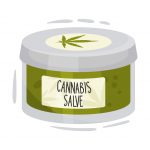Jillian Stansbury, ND
The Petasites genus comprises 15 to 20 species, and all have been used to treat pain, inflammation, and allergic hyperreactivity. Petasites species are large-leaved, moisture-loving plants native to temperate woodlands of northern Asia, Europe, and North America. They are sometimes referred to by the general name sweet coltsfoot because of similarity to Tussilago. Petasites are in the Senecioneae tribe of the Asteraceae family. Petasites hybridus, the most common Petasites species in the United States, goes by the common name butterbur, reportedly because the large leaves were convenient to wrap and preserve fresh butter in root cellars of pioneer farms. Petasites japonicus is found in Asia and is known as fuki in Japan and as giant butterbur and bog rhubarb in English-speaking locales where it has been introduced. Petasites frigidus grows in seasonal streambeds of the Pacific Northwest.
I have chosen to feature Petasites herein because its pain-relieving effects are often overlooked. In the modern era, medical conferences devoted entirely to Petasites have convened in Switzerland (such as one in March 1996) for scientists to share their research on the plant. I first started using Petasites for difficult types of pain such as that in patients with terminal cancer and for bone metastasis, as suggested by R. F. Weiss in his book Herbal Medication.1 Anecdotally, I have found that Petasites is helpful in reducing the need for other pharmaceuticals and sedatives, which in many cases may cause patients with terminal illness to spend their last months heavily sedated, if not asleep and unable to spend time with their families. While you will not find published studies on Petasites for cancer or general pain, numerous investigations have been performed on the plant’s anti-inflammatory, antiallergy, and antispasmodic effects, all possible contributors to an anodyne action. Petasites seems most specific for pain of the vasculature and for other smooth muscle spasms in hollow organs such as the bronchi and, to a lesser extent, the ureters and possibly the bladder.
Etymology and Ethnobotanical History
The word Petasites may derive from the Greek petasos, referring to a hat of the variety that the Greek god Mercury is usually pictured wearing. Because of the large, almost umbrellalike leaves, Petasites indeed may have come in handy as a hat.
Both the leaves and the roots of Petasites species are used as medicines, with the roots reported to have stronger antispasmodic effects. Petasites has been used as a general anodyne in both European and Asian folklore and is reported to be useful for asthma, allergies, hypertension, chest pain, migraine, vascular pain, and pain due to ulcers. Petasites was reportedly used during the Middle Ages for symptoms of the plague. Petasites is consumed as a vegetable in Japan, where folklore associates its intake with antiallergy and anti-inflammatory effects. The young spring stalks and growth are soaked in ashes or baking soda water to reduce the astringency, and they are then sliced and stir-fried with miso and spices to prepare a condiment to serve with soups and rice.
An overview of the constituents of Petasites is given in the Table. Also included are some of its folkloric indications.
Anodyne Mechanisms of Action
The butterbur plant, P hybridus, has been used for centuries for all manner of painful and inflammatory conditions and has been found to be anti-inflammatory by numerous mechanisms. Petasites inhibits cyclooxygenase and inflammatory prostaglandin and may inhibit the formation of inflammatory leukotrienes12; in particular, Petasites administration has been noted to induce the formation of peptidoleukotrienes released from macrophages. Animal models of asthma have shown P japonicus to inhibit the release of interleukins and tumor necrosis factor, without evidence of cytotoxicity.13 Petasites has also been shown to have effects on mast cells, with 1000 mg/kg reducing the release of histamine and leukotrienes from mast cells in animal investigations, as well as decreasing airway constriction typically induced by these substances.14
It has been proposed that Petasites may reduce general oxidative stress in the body by normalizing blood lipid levels and upregulating liver detoxification pathways. Petasites has been shown to support the antioxidant enzyme systems of the liver, including glutathione reductase, peroxidase, and transferases.15 Furthermore, Petasites reduced total cholesterol and low-density lipoprotein cholesterol levels and contributed to normalizing blood lipid profiles.15 By helping to reduce oxidative stress, Petasites can have neuroprotective and antiseizural effects.16,17
Petasites hybridus has a long history of use for migraine headaches, and more recent research shows that Petasites may reduce inappropriate vasoconstriction via a mechanism that involves blocking calcium-gated channels in the vasculature.18-22 Petasites may also relax bronchoconstriction via activity at muscarinic sites14,23 and may reduce corticosterone release from the adrenal gland and inhibit cyclic adenosine monophosphate–driven enzyme activation, serving to deter contraction of smooth muscles.24,25 Animal studies18,19 have shown Petasites to reduce excessive contractility in heart muscle fibers due to the effects of S-petasin on intracellular calcium. In effect, Petasites could be considered a negative chronotropic and inotropic agent, in contrast to cardiac glycosides, which are positive inotropic and chronotropic agents. While cardiac glycosides such as Digitalis and Convallaria are indicated for heart failure, Petasites might be considered for hypertension, excessive vasoconstriction, and tachyarrhythmias and excitability. Asthma is improved by a similar mechanism, relaxing the smooth muscle of the airways via calcium channel inhibition. This also suggests that Petasites may be contraindicated in patients with cardiomyopathy; however, some of the folkloric literature indicates the plant may be cardiotonic, and no adverse effects on the heart have been reported in any modern clinical trials to date.
Petasites for Migraines and Chronic Headaches
Several reviews of almost 300 research studies on various alternative nonsteroidal therapies for patients with migraine rate Petasites as a top-tier effective natural option for reducing the frequency and severity of migraine headaches.26-29 Several human clinical trials have demonstrated the efficacy of Petasites for migraine prevention. A randomized placebo-controlled trial30 showed that Petasites root extracts (dosed at 25 mg twice daily) reduced migraine frequency by 45% in 4 weeks among those receiving the verum and by 15% among those receiving placebo. A similar study31 among adults with chronic headaches reported a 48% reduction in headaches with a 75-mg twice daily dosage of Petasites root in 4 months’ time. In another study32 of Petasites for children and adolescents experiencing chronic headaches, 91% of participants reported some improvement after 4 months of treatment, and 77% demonstrated a 50% reduction in migraine attacks. The most common adverse effect reported was eructations, and no adverse events were serious.
Petasites and Allergic Airway Diseases
Petasites has numerous antiallergy effects, explaining the folkloric use of the plants for asthma, spastic cough, and airway reactivity. Leukotriene synthesis in eosinophils and neutrophils is inhibited, while elevated eosinophil and blood nitric oxide levels are reduced. Petasites also inhibits cyclooxygenase, an enzyme involved in the synthesis of inflammatory prostaglandins. Petasites japonicus reduces leukotriene and histamine-induced bronchoconstriction.
One clinical trial33 reported that Petasites alleviated symptoms of allergic rhinitis in a manner equal to antihistamine pharmaceutical agents, and another clinical trial34 showed a statistically significant reduction in symptoms of allergic rhinitis compared with placebo in as little as 7 days. Another human clinical study35 showed that Petasites (50 mg) for just 1 week reduced the symptoms of allergic rhinitis equivalent to the prescription medicine fexofenadine hydrochloride.
A small clinical trial36 of patients with asthma reported that P hybridus root extracts reduced the severity, frequency, and duration of asthma attacks. Among those using asthma medications and inhalers, 40% of study participants required less medication at the end of the 2-month study compared with baseline, and improved spirometry readings were demonstrated. A review of clinical trials on Petasites suggests efficacy for allergy and asthma,37 which warrants further investigation.
Petasites, Pyrrolizidine Alkaloids, and Hepatotoxicity
As is the case with other plants noted to contain pyrrolizidine alkaloids, P hybridus may have hepatotoxic effects. Many plants of the Senecioneae tribe of the Asteraceae family are noted to contain pyrrolizidine alkaloids, which are highest in the stalks and rhizomes and lowest in the leaves. Products prepared by a quality laboratory are recommended to ensure that the pyrrolizidine alkaloids do not become abnormally elevated.
One study38 of P hybridus showed no signs of hepatocellular toxic effects at serum levels of 69 ng/mL, a typical blood level with normal dosing. At 200 times this dosage, transient elevations in liver bilirubin and transaminases can be observed, which then return to normal when the overdosing is withdrawn. Any potential liver irritation has been credited to petasin, which is thought to impair bile acid transport and liver and protein metabolism, but only at therapeutic dosages that are significantly above normal.
Formulas for Conditions That May Respond to Petasites
Migraine and Chronic Head Pain
To reduce the frequency and severity of migraine and chronic headaches, a formula such as the following should be used: Petasites (25 mL), Tanacetum (15 mL), Curcuma (10 mL), and Hypericum (10 mL).
Vascular Spasm Due to Inflammation
A formula such as the following may help allay spasm pain due to tumors and vascular inflammation: Petasites (15 mL), Aesculus (15 mL), Angelica (15 mL), and Salvia miltiorrhiza (15 mL).
Acute Anginal Coronary Spasm
Petasites may be helpful for acute and episodic use in the treatment of angina, but circulatory-enhancing agents and cardiac glycosides such as Convallaria may be superior for long-term trophorestorative and supportive therapy in patients with heart failure. The following formula may be used for acute anginal coronary spasm (2 teaspoons every 5 minutes, reducing as symptoms improve): Petasites (20 mL), Lobelia (20 mL), Gingko (10 mL), Allium (8 mL), and Mentha essential oil (2 mL).
Acute Chest Pain and Tightness
Wheezing and a tight heavy sensation in the chest will often respond to the following formula, which is best used acutely with a separate protocol in place to help reduce allergic hyperreactivity via diet, antioxidant supplements, and long-term herbal therapies: Lobelia (18 mL), Petasites (18 mL), Angelica (10 mL), Gingko (10 mL), and Eucalyptus essential oil (4 mL).
Acute Spastic Cough
For cough-variant asthma and for spastic coughing due to infections and bronchitis, the following formula can be taken hourly, reducing as symptoms improve: Petasites (15 mL), Lobelia (15 mL), Tussilago (10 mL), Thymus (10 mL), Foeniculum (8 mL), and Eucalyptus essential oil (2 mL).
 Jillian Stansbury, ND has practiced in SW Washington for nearly 20 years, specializing in women’s health, mental health and chronic disease. She holds undergraduate degrees in medical illustration and medical assisting, and graduated with honors in both programs. Dr Stansbury also chaired the botanical medicine program at NCNM and has taught the core botanical curricula for more than 20 years. In addition, Dr Stansbury also writes and serves as a medical editor for numerous professional journals and lay publications, plus teaches natural products chemistry and herbal medicine around the country. At present she is working to set up a humanitarian service organization in Peru and studying South American ethnobotany. She is the mother of two adult children, and her hobbies include art, music, gardening, camping, international travel, and studying quantum and metaphysics.
Jillian Stansbury, ND has practiced in SW Washington for nearly 20 years, specializing in women’s health, mental health and chronic disease. She holds undergraduate degrees in medical illustration and medical assisting, and graduated with honors in both programs. Dr Stansbury also chaired the botanical medicine program at NCNM and has taught the core botanical curricula for more than 20 years. In addition, Dr Stansbury also writes and serves as a medical editor for numerous professional journals and lay publications, plus teaches natural products chemistry and herbal medicine around the country. At present she is working to set up a humanitarian service organization in Peru and studying South American ethnobotany. She is the mother of two adult children, and her hobbies include art, music, gardening, camping, international travel, and studying quantum and metaphysics.
References
Weiss RF. Herbal Medicine. Meuss AR, trans. Beaconsfield, England: Beaconsfield Publishers; 1988:90
Wang GJ, Lin YL, Chen CH, Wu XC, Liao JF, Ren J. Cellular calcium regulatory machinery of vasorelaxation elicited by petasin. Clin Exp Pharmacol Physiol. 2010;37(3):309-315.
Bickel D, Roder T, Bestmann HJ, Brune K. Identification and characterization of inhibitors of peptido-leukotriene–synthesis from Petasites hybridus. Planta Med. 1994;60(4):318-322.
Petzinger E. Pyrrolizidine alkaloids and seneciosis in farm animals, part 2: clinical signs, species-specific sensitivity, food residues, feed contamination, limit values [in German]. Tierarztl Prax Ausg G Grosstiere Nutztiere. 2011;39(6):363-372.
Kim SM, Kang SW, Jeon JS, et al. Rapid identification and evaluation of antioxidant compounds from extracts of Petasites japonicus by hyphenated-HPLC techniques. Biomed Chromatogr. 2012;26(2):199-207.
Mohammadi M, Yousefi M, Habibi Z, Dastan D. Chemical composition and antioxidant activity of the essential oil of aerial parts of Petasites albus from Iran: a good natural source of euparin. Nat Prod Res. 2012;26(4):291-297.
Sun ZL, Gao GL, Luo JY, Zhang XL, Zhang M, Feng J. A new neuroprotective bakkenolide from the rhizome of Petasites tatewakianus. Fitoterapia. 2011;82(3):401-404.
Ko WC, Lei CB, Lin YL, Chen CF. Relaxant effects of petasin in isolated guinea pig trachea and their structure-activity relationships. Planta Med. 2000;66(7):650-652.
Grieve M. A Modern Herbal. New York, NY: Dover Publications Inc; 1931.
Gerard J. The Herball. London, England; 1597.
Culpepper N. The Complete Herbal. 1653.
Brune K, Bickel D, Peskar BA. Gastro-protective effects by extracts of Petasites hybridus: the role of inhibition of peptido-leukotriene synthesis. Planta Med. 1993;59(6):494-496.
Ma J, Cheng G, Li D, Liu H. The effects of Radix puerariae decoction on levels of antibody and interleukin-2 in mice [in Chinese]. Zhong Yao Cai. 2002;25(10):731-732.
9. Shimoda H, Tanaka J, Yamada E, Morikawa T, Kasajima N, Yoshikawa M. Anti type I allergic property of Japanese butterbur extract and its mast cell degranulation inhibitory ingredients. J Agric Food Chem. 2006;54(8):2915-2920.
Park CH, Kim MY, Sok DE, Kim JH, Lee JH, Kim MR. Butterbur (Petasites japonicus Max.) extract improves lipid profiles and antioxidant activities in monosodium l-glutamate–challenged mice. J Med Food. 2010;13(5):1216-1223.
Oh SH, Sok DE, Kim MR. Neuroprotective effects of butterbur and rough aster against kainic acid–induced oxidative stress in mice. J Med Food. 2005;8(2):169-176.
Sok DE, Oh SH, Kim YB, Kang HG, Kim MR. Neuroprotection by extract of Petasites japonicus leaves, a traditional vegetable, against oxidative stress in brain of mice challenged with kainic acid. Eur J Nutr. 2006;45(2):61-69.
Sheykhzade M, Smajilovic S, Issa A, Haunso S, Christensen SB, Tfelt-Hansen J. S-petasin and butterbur lactones dilate vessels through blockage of voltage gated calcium channels and block DNA synthesis. Eur J Pharmacol. 2008;593(1-3):79-86.
Wang GJ, Liao JF, Hintz KK, et al. Calcium-antagonizing activity of S-petasin, a hypotensive sesquiterpene from Petasites formosanus, on inotropic and chronotropic responses in isolated rat atria and cardiac myocytes. Naunyn Schmiedebergs Arch Pharmacol. 2004;369(3):322-329.
Esberg LB, Wang GJ, Lin YL, Ren J. Iso-S-petasin, a hypotensive sesquiterpene from Petasites formosanus, depresses cardiac contraction and intracellular Ca2+ transients in adult rat ventricular myocytes. J Pharm Pharmacol. 2003;55(1):103-107.
Wu SN, Chen H, Lin YL. The mechanism of inhibitory actions of S-petasin, a sesquiterpene of Petasites formosanus, on l-type calcium current in NG108-15 neuronal cells. Planta Med. 2003;69(2):118-124.
Thomet OA, Wiesmann UN, Schapowal A, Bizer C, Simon HU. Role of petasin in the potential anti-inflammatory activity of a plant extract of Petasites hybridus. Biochem Pharmacol. 2001;61(8):1041-1047.
Lin LH, Huang TJ, Wang SH, Lin YL, Wu SN, Ko WC. Bronchodilatory effects of S-isopetasin, an antimuscarinic sesquiterpene of Petasites formosanus, on obstructive airway hyperresponsiveness. Eur J Pharmacol. 2008;584(2-3):398-404.
Chang LL, Wun WS, Lin YL, Wang PS. Effects of S-petasin on cyclic AMP production and enzyme activity of P450scc in rat zona fasciculata-reticularis cells. Eur J Pharmacol. 2004;489(1-2):29-37.
Chang LL, Tseng YC, Lin YL, Wun WS, Wang PS. Effects of S-petasin on corticosterone release in rats. Chin J Physiol. 2002;45(4):137-142.
Holland S, Silberstein SD, Freitag F, Dodick DW, Argoff C, Ashman E. Evidence-based guideline update: NSAIDs and other complementary treatments for episodic migraine prevention in adults: report of the Quality Standards Subcommittee of the American Academy of Neurology and the American Headache Society. Neurology. 2012;78(17):1346-1353.
Lovell BV, Marmura MJ. New therapeutic developments in chronic migraine. Curr Opin Neurol. 2010;23(3):254-258.
Sun-Edelstein C, Mauskop A. Foods and supplements in the management of migraine headaches. Clin J Pain. 2009;25(5):446-452.
Rios J, Passe MM. Evidenced-based use of botanicals, minerals, and vitamins in the prophylactic treatment of migraines. J Am Acad Nurse Pract. 2004;16(6):251-256.
Diener HC, Rahlfs VW, Danesch U. The first placebo-controlled trial of a special butterbur root extract for the prevention of migraine: reanalysis of efficacy criteria. Eur Neurol. 2004;51(2):89-97.
Lipton RB, Göbel H, Einhäupl KM, Wilks K, Mauskop A. Petasites hybridus root (butterbur) is an effective preventive treatment for migraine. Neurology. 2004;63(12):2240-2244.
Pothmann R, Danesch U. Migraine prevention in children and adolescents: results of an open study with a special butterbur root extract. Headache. 2005;45(3):196-203.
Schapowal A; Study Group Treating Intermittent Allergic Rhinitis. A prospective, randomized, placebo and antihistamine-controlled study of butterbur extract Ze 339. Phytother Res. 2005;19(6):530-537.
Schapowal A; Petasites Study Group. Butterbur Ze339 for the treatment of intermittent allergic rhinitis: dose-dependent efficacy in a prospective, randomized, double-blind, placebo-controlled study. Arch Otolaryngol Head Neck Surg. 2004;130(12):1381-1386.
Lee DK, Gray RD, Robb FM, Fujihara S, Lipworth BJ. A placebo-controlled evaluation of butterbur and fexofenadine on objective and subjective outcomes in perennial allergic rhinitis. Clin Exp Allergy. 2004;34(4):646-649.
Danesch UC. Petasites hybridus (butterbur root) extract in the treatment of asthma: an open trial. Altern Med Rev. 2004;9(1):54-62.
Guo R, Pittler MH, Ernst E. Herbal medicines for the treatment of allergic rhinitis: a systematic review. Ann Allergy Asthma Immunol. 2007;99(6):483-495.
Anderson N. Toxicogenomics applied to cultures of human hepatocytes enabled an identification of novel Petasites hybridus extracts for the treatment of migraine with improved hepatobiliary safety. Toxicol Sci. 2009;112(2):507-520.





